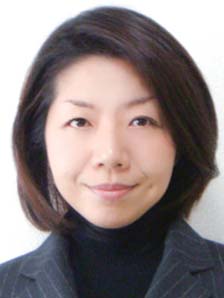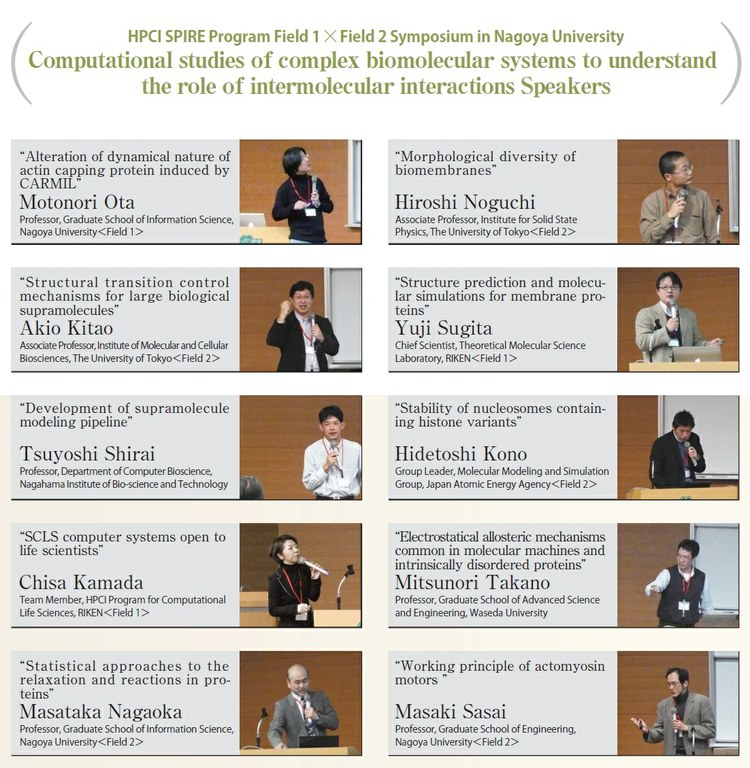Special Feature 2:Collaboration between SPIRE Field1×Field2
 |
Chisa Kamada
|
|---|
Field 1 and Field 2 Joint Symposium
A symposium entitled “HPCI SPIRE Program Field 1 × Field 2 Symposium in
Nagoya University Computational studies of complex biomolecular systems to understand the role of intermolecular interactions”was held on Tuesday, December 17,2013 in the lecture hall of the IB Building at Nagoya University.
In HPCI SPIRE Field 1, various symposiums and seminars have been held to foster better understanding of the HPCI and computer simulations in life sciences and disseminate our research outcomes and activities for researchers (including those who work in private sector companies) and the general public by dividing the country into six blocks : Hokkaido/-Tohoku, Kanto, Chubu, Kansai, Chugoku and Kyushu/Okinawa. For this symposium, Professor Motonori Ota of the Graduate School of Information Science at Nagoya University, a Field 1 member, served as facilitator. As Nagoya University has many researchers who are studying biomolecules in Field 2, Professor Ota suggested the idea of holding a joint symposium with Field 2. In response, Professor Masaki Sasai of the Graduate School of Engineering at Nagoya University, a Field 2 member, also agreed to serve as facilitator, and the symposium was held by collaboration t between Field 1 and Field 2.
Exploration of life phenomena and the role of high-performance computing
The keywords for the symposium were complex systems, interaction and high-performance computing. At the opening session, Professor Ota stated the main point of the symposium as follows : “The interaction between molecules holds the first key to the understanding of cooperative phenomena in complex biomolecular systems.” He followed this up by saying,“An issue we should be resolved is understandhow increasing amount of data and its calculation by high performance computing link to qualitative understanding of life phenomena.” Each of the speakers alsogave presentations on various research topics that were in line with this basic
theme of the symposium.*
To me, the presentations were fresh and inspiring. This was because of the effort to identify the truth in the very minuscale movements (or perhaps we should refer to them as behavior) of hemoglobins and nucleosomes and so on, which we all learned about in biology classes in junior high and high school, and because of the diverse approaches of many researchers studying the same research topic. Hemoglobin, for instance, is known to transport oxygen in the blood with binding iron(heme). However, a close look at this mechanism reveals that, once the first heme subunit binds oxygen molecule, binding the second, third and fourth oxygen molecules gets progressively easier and easier. Conversely as well, when the oxygen is released, a cooperative phenomenon known as the allosteric mechanism appears and causes the oxygen to be separated in order the first time, the second time and so on. Extremely complex calculations are needed to understand these microscopic mechanisms, making us realize again the major role played by high-performance computing.
Collaboration between computer simulations and experiments
Another impressive point in the symposium was the explanation given by Visiting
Professor Yuichiro Maeda (Structural Biology Research Center, Nagoya University), Ota' scollaborative researcher, during the question and answer period following Professor Ota's presentation. The catalyst for the decision of these two professors to begin collaborative research was the fact that, in order to pursue their research, they needed to go back and forth between conducting experimental measurements in order to investigate the structural dynamics and then combining these results with the results of computer calculations. “Collaboration between computer simulations and experiments” is a phrase that is frequently used by researchers in conversation with one another during projects, but I was able to get a clearer picture of it after listening to a description of the process in a debate setting.
There were spirited question and answer sessions after each of the presentations.At the closing session, Professor Sasai summed up the symposium as follows : “Although Field 1 and Field 2 both target biomolecules, the background is different in these two fields. However, I think it is meaningful for us to experience wide variety of different research styles.” I felt strongly that, as in the case of the cooperative phenomenon of biomolecules, it is important for us in our research as well to continue to pursue activities that go beyond disciplinary boundaries.
* Summaries of the lectures presented at the symposium are available on the Field 1 website.
http://www.kobe.riken.jp/stpr1-life/index.html

 |
The SCLS motto: “Go find a punchline! “ The name SCLS stands for Supercomputational Life Science. At SCLS, researchers simulate the complex, diverse behavior of living systems to reveal important principles of human health and disease, with the ultimate goal of enabling discovery of new medicines. “Just as a joke isn’ t funny without the punchline, science needs more than results ― it needs the equivalent of a “punchline” to complete it,” says Director Toshio Yanagida. In response to his enthusiastic encouragement, all project members work hard day after day. |
|---|

